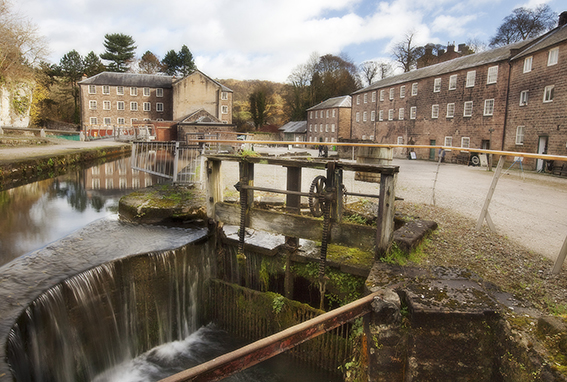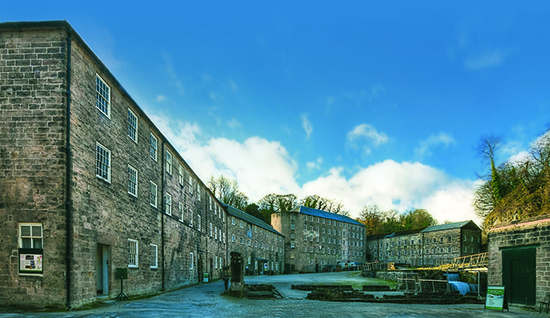Having been extended due to popular demand, Tangled Yarns finished at the William Morris Gallery on 1 February. I was exhilarated from the amazing feedback and reviews, but also completely exhausted. So the end of the exhibition was also a natural end of this blog ….except the exhibition is touring! From 26 September, Tangled Yarns can be seen at Cromford Mills, part of the picturesque Derwent Valley Mills World Heritage Site in Derbyshire. Built between 1771 and 1791, Sir Richard Arkwright’s Mills at Cromford were the world’s first successful water powered cotton spinning mills and the blueprint of modern factory production.
It all started with a proposal from Cromford Mills to host the exhibition, and an exploratory visit to Cromford Mills on a cold, rainy day in mid-January. My first impression was how incredibly green the Derwent Valley is, even when looking through driving rain. I was met at the station by Mark, one of Cromford’s volunteers and a sheer inexhaustible source of knowledge about the mill and its history. He gave me a fascinating tour round the site which – second impression – seemed to be built like a fortress.
That’s by design, explained Mark, to make the factory easily defendable against machine-breakers. The first inkling of just how significant Cromford was in terms of industrial history, labour history and the history of textile production. At the end of my day at Cromford and hearing about how Arkwright’s inventions led to the birth of the once mighty British cotton industry I was hooked. What a fitting venue for Tangled Yarns! And of course I wanted to make at least on new piece that responded specifically to the site.
First though, a much-deserved holiday in hot and sunny India (including the inevitable fabric shopping spree). And then, just as I was ready to get back into the studio (and the books on Richard Arkwright) I got seriously ill – out of the blue it seemed… but then I had been very run down. That knocked me out of several months – and gave rise to some thoughts about work-life balance and managing energy- and stress-levels in future. Luckily, I recovered just in time to start making my Cromford-inspired piece. It’s not yet finished, of course, but then there’s still a few weeks to go! And by now I even have enough of my energy back to continue this blog with a few posts about my preparations for the Cromford Mills show.
Researching Sir Richard Arkwright has been fascinating. Right from the start I sensed that I wanted to know more about this man, inventor of the water spinning frame and the carding engine. Looking at Joseph Wright of Derby’s portraits I got the impression of a very smart, confident, and just a tad shifty businessman, the size of his proud belly a measure of his success.
How come that he became so rich and successful whereas Samuel Cromptom, whose spinning mule was arguably a more significant invention, died a pauper? The short answer must be that Arkwright was a better businessman. And his business acumen must have been the driving force behind his most important invention: the modern factory system. More on this in the next post.



